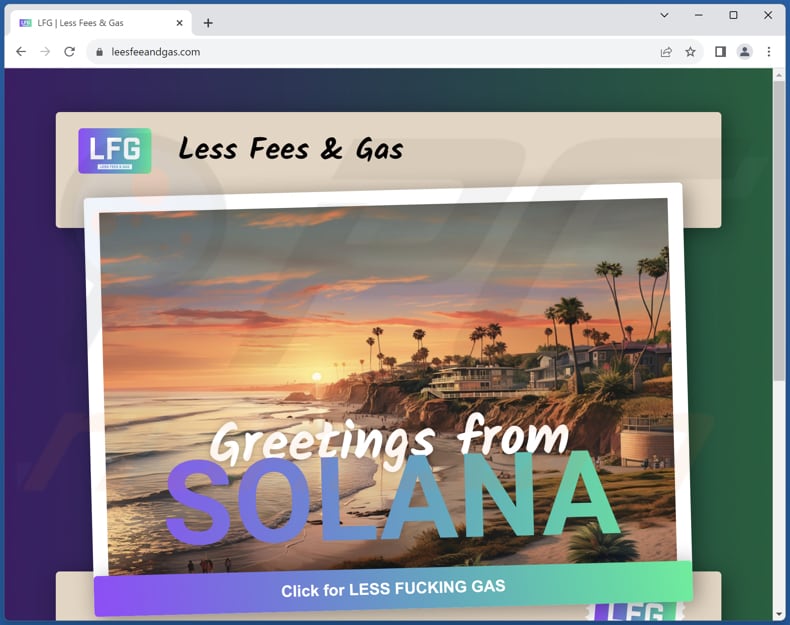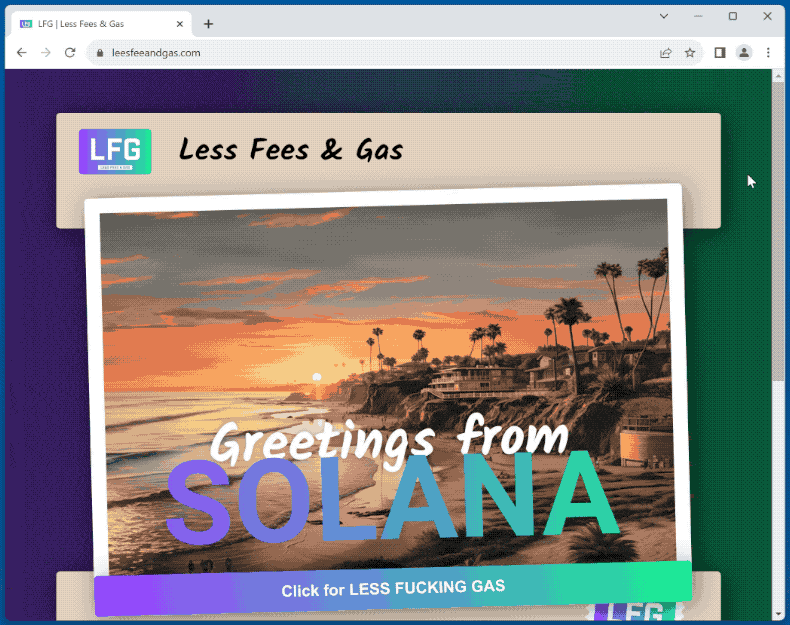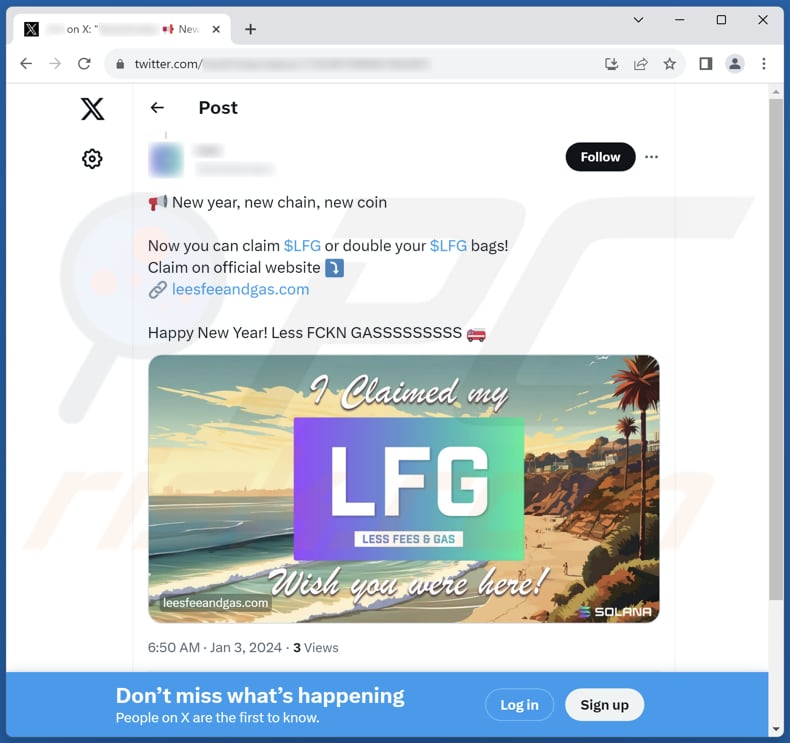How to avoid falling for scams like "Less Fees & Gas"
Phishing/ScamAlso Known As: Less Fees & Gas fake giveaway
Get free scan and check if your device is infected.
Remove it nowTo use full-featured product, you have to purchase a license for Combo Cleaner. Seven days free trial available. Combo Cleaner is owned and operated by RCS LT, the parent company of PCRisk.com.
What is "Less Fees & Gas"?
Following a meticulous examination, it has been determined that this operates as a fraudulent scheme masquerading as a cryptocurrency giveaway. Perpetrators utilize X (Twitter) and deceptive methods to lure users into participating in their scam with the ultimate goal of pilfering cryptocurrency from their wallets.

"Less Fees & Gas" in detail
The deceptive post on X (Twitter) promotes a scam under the guise of celebrating the new year with a purported new cryptocurrency. The post encourages users to claim or double their $LFG holdings, providing a link to an official-looking website (leesfeeandgas[.]com). It uses enthusiastic language, wishes a happy new year, and emphasizes the concept of "LESS FEES & GAS".
On the fake website, scammers claim to have discovered a fast, secure, and decentralized future. They entice users with the promise of a "little gift" to substantiate the reality of this discovery. The call-to-action prompts users to click the provided button, suggesting a cryptocurrency-related benefit.
Executing the steps outlined upon clicking the presented button leads to the authorization of a malicious contract. The purpose of this contract is to activate a drainer explicitly crafted for executing unauthorized transactions. Once triggered, the drainer enables the illicit transfer of digital currency from the victim's wallet to the scammer's wallet, resulting in the loss of cryptocurrency.
It is crucial to understand that reclaiming stolen cryptocurrency poses significant challenges, marked by a complex and intricate process. Cryptocurrency transactions are typically irreversible, making it difficult to trace and recover funds once they have been transferred.
| Name | Less Fees & Gas fake giveaway |
| Threat Type | Phishing, Scam, Social Engineering, Fraud |
| Fake Claim | Participants are eligible for free cryptocurrency |
| Disguise | Legitimate cryptocurrency giveaway |
| Related Domain | leesfeeandgas[.]com |
| Detection Names | Avira (Malware), Cluster (Phishing), CRDF (Malicious), Emsisoft (Phishing), Seclookup (Malicious), Full List Of Detections (VirusTotal) |
| Symptoms | Lack of official verification, unrealistic claims, too good-to-be-true promises. |
| Distribution methods | Post on X (Twitter), deceptive websites, rogue online pop-up ads, potentially unwanted applications. |
| Damage | Loss of sensitive private information, monetary loss, identity theft, possible malware infections. |
| Malware Removal (Windows) |
To eliminate possible malware infections, scan your computer with legitimate antivirus software. Our security researchers recommend using Combo Cleaner. Download Combo CleanerTo use full-featured product, you have to purchase a license for Combo Cleaner. 7 days free trial available. Combo Cleaner is owned and operated by RCS LT, the parent company of PCRisk.com. |
Conclusion
In conclusion, the deceptive cryptocurrency giveaway operates by misleading users into approving a malicious contract, resulting in the unauthorized transfer of digital currency from victims to scammers. Recovery of stolen funds is inherently challenging due to the irreversible nature of cryptocurrency transactions.
This underscores the importance of vigilance and caution to prevent falling victim to such scams in the first place. Examples of similar scams involving a cryptocurrency drainer are "Diamondhands Wallet Analyser", "Jito (JTO) Token Airdrop", and "MASK Token Airdrop".
How did I open a scam website?
Users often land on scam websites through phishing emails or messages that appear authentic, enticing users to click on embedded links that lead to fraudulent sites. These messages may mimic official communications from trusted entities, exploiting users' trust to direct them to scam pages.
Additionally, misleading advertisements and pop-ups on dubious pages contribute to users unintentionally navigating to scam websites. Sometimes, manipulated search engine results, notifications from suspicious sites, and adware may lead users to these deceptive pages.
How to avoid visiting scam pages?
Stick to well-known and reputable search engines to minimize the chances of encountering manipulated search results. Refrain from clicking on links in unsolicited emails and messages or interacting with ads and pop-ups on questionable websites. Ensure your browser, antivirus software, and operating system are up-to-date with the latest security patches.
Obtain files and applications from trustworthy sources, such as official websites and app stores. Employ a reputable security tool and run system scans regularly. If your computer is already infected with unwanted apps, we recommend running a scan with Combo Cleaner Antivirus for Windows to automatically eliminate them.
The appearance of "Less Fees & Gas" scam (GIF):

Post on X (Twitter) promoting the scam:

Instant automatic malware removal:
Manual threat removal might be a lengthy and complicated process that requires advanced IT skills. Combo Cleaner is a professional automatic malware removal tool that is recommended to get rid of malware. Download it by clicking the button below:
DOWNLOAD Combo CleanerBy downloading any software listed on this website you agree to our Privacy Policy and Terms of Use. To use full-featured product, you have to purchase a license for Combo Cleaner. 7 days free trial available. Combo Cleaner is owned and operated by RCS LT, the parent company of PCRisk.com.
Quick menu:
- What is Less Fees & Gas fake giveaway?
- How to identify a pop-up scam?
- How do pop-up scams work?
- How to remove fake pop-ups?
- How to prevent fake pop-ups?
- What to do if you fell for a pop-up scam?
How to identify a pop-up scam?
Pop-up windows with various fake messages are a common type of lures cybercriminals use. They collect sensitive personal data, trick Internet users into calling fake tech support numbers, subscribe to useless online services, invest in shady cryptocurrency schemes, etc.
While in the majority of cases these pop-ups don't infect users' devices with malware, they can cause direct monetary loss or could result in identity theft.
Cybercriminals strive to create their rogue pop-up windows to look trustworthy, however, scams typically have the following characteristics:
- Spelling mistakes and non-professional images - Closely inspect the information displayed in a pop-up. Spelling mistakes and unprofessional images could be a sign of a scam.
- Sense of urgency - Countdown timer with a couple of minutes on it, asking you to enter your personal information or subscribe to some online service.
- Statements that you won something - If you haven't participated in a lottery, online competition, etc., and you see a pop-up window stating that you won.
- Computer or mobile device scan - A pop-up window that scans your device and informs of detected issues - is undoubtedly a scam; webpages cannot perform such actions.
- Exclusivity - Pop-up windows stating that only you are given secret access to a financial scheme that can quickly make you rich.
Example of a pop-up scam:

How do pop-up scams work?
Cybercriminals and deceptive marketers usually use various advertising networks, search engine poisoning techniques, and shady websites to generate traffic to their pop-ups. Users land on their online lures after clicking on fake download buttons, using a torrent website, or simply clicking on an Internet search engine result.
Based on users' location and device information, they are presented with a scam pop-up. Lures presented in such pop-ups range from get-rich-quick schemes to fake virus scans.
How to remove fake pop-ups?
In most cases, pop-up scams do not infect users' devices with malware. If you encountered a scam pop-up, simply closing it should be enough. In some cases scam, pop-ups may be hard to close; in such cases - close your Internet browser and restart it.
In extremely rare cases, you might need to reset your Internet browser. For this, use our instructions explaining how to reset Internet browser settings.
How to prevent fake pop-ups?
To prevent seeing pop-up scams, you should visit only reputable websites. Torrent, Crack, free online movie streaming, YouTube video download, and other websites of similar reputation commonly redirect Internet users to pop-up scams.
To minimize the risk of encountering pop-up scams, you should keep your Internet browsers up-to-date and use reputable anti-malware application. For this purpose, we recommend Combo Cleaner Antivirus for Windows.
What to do if you fell for a pop-up scam?
This depends on the type of scam that you fell for. Most commonly, pop-up scams try to trick users into sending money, giving away personal information, or giving access to one's device.
- If you sent money to scammers: You should contact your financial institution and explain that you were scammed. If informed promptly, there's a chance to get your money back.
- If you gave away your personal information: You should change your passwords and enable two-factor authentication in all online services that you use. Visit Federal Trade Commission to report identity theft and get personalized recovery steps.
- If you let scammers connect to your device: You should scan your computer with reputable anti-malware (we recommend Combo Cleaner Antivirus for Windows) - cyber criminals could have planted trojans, keyloggers, and other malware, don't use your computer until removing possible threats.
- Help other Internet users: report Internet scams to Federal Trade Commission.
Frequently Asked Questions (FAQ)
What is fake cryptocurrency giveaway?
These scams often involve false promises of free cryptocurrency or tokens, enticing participants to take specific actions.
What is the purpose of a fake crypto giveaway?
The objective of a fake crypto giveaway is to deceive individuals and trick them into providing their cryptocurrency or personal information to scammers. The ultimate aim is financial gain for the scammers.
How fake cryptocurrency giveaways are promoted?
Scammers use various tactics, including notifications from dubious pages, rogue advertising networks, false promotions, fake social media accounts, and misleading advertisements, to create the illusion of a legitimate giveaway while exploiting unsuspecting participants.
Will Combo Cleaner protect me from scams?
Combo Cleaner is designed to conduct comprehensive scans of every website you visit, effectively detecting malicious sites, including those linked to scams. The application notifies users and limits access to suspicious pages.
Share:

Tomas Meskauskas
Expert security researcher, professional malware analyst
I am passionate about computer security and technology. I have an experience of over 10 years working in various companies related to computer technical issue solving and Internet security. I have been working as an author and editor for pcrisk.com since 2010. Follow me on Twitter and LinkedIn to stay informed about the latest online security threats.
PCrisk security portal is brought by a company RCS LT.
Joined forces of security researchers help educate computer users about the latest online security threats. More information about the company RCS LT.
Our malware removal guides are free. However, if you want to support us you can send us a donation.
DonatePCrisk security portal is brought by a company RCS LT.
Joined forces of security researchers help educate computer users about the latest online security threats. More information about the company RCS LT.
Our malware removal guides are free. However, if you want to support us you can send us a donation.
Donate
▼ Show Discussion